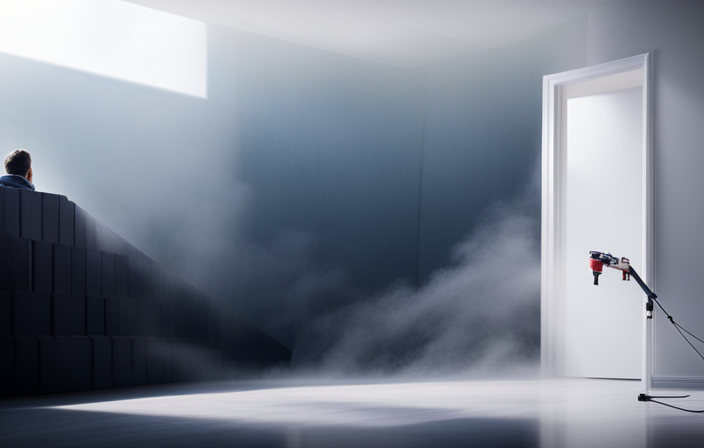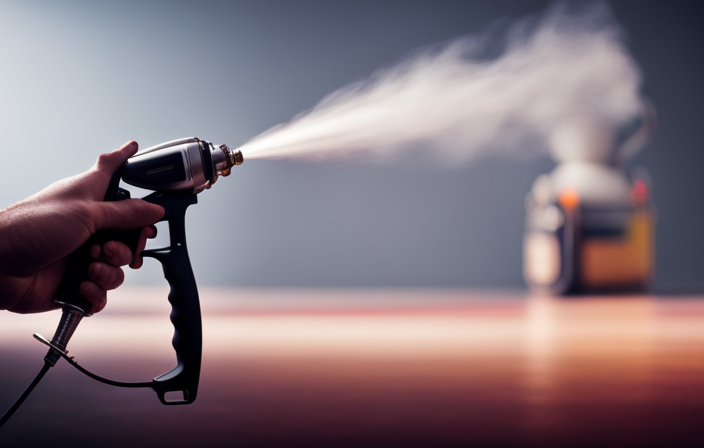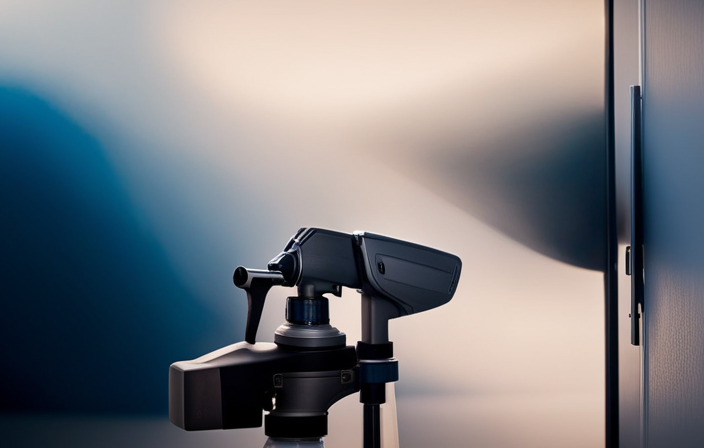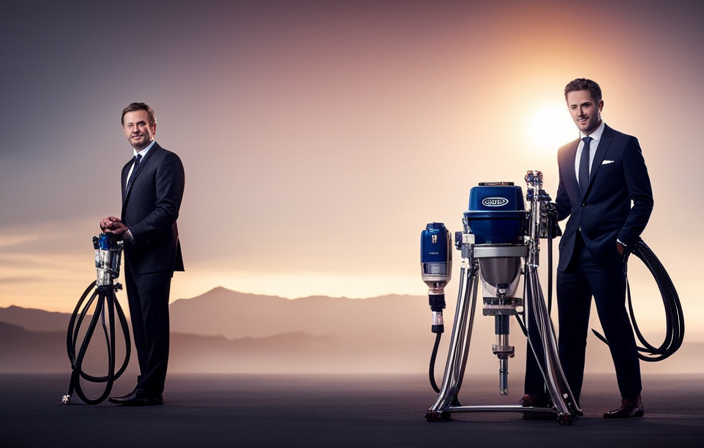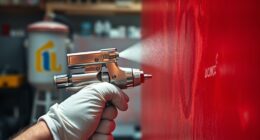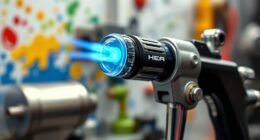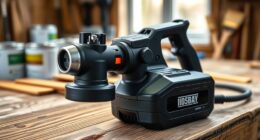Did you know that using an airless paint sprayer can help you save time and money on your painting projects? With its ability to quickly and effectively cover large areas, an airless paint sprayer is a valuable tool for both beginners and experienced painters.
But, one question that often arises is whether or not a second coat is necessary when using this type of sprayer.
In this article, I will delve into the factors that determine the need for a second coat when using an airless paint sprayer. We will explore the coverage of the first coat, the evenness of the application, and the potential benefits of applying a second coat for enhanced durability and longevity. By understanding these factors, you will be able to make an informed decision on whether or not a second coat is needed for your specific painting project.
So, let’s dive in and discover the ins and outs of using an airless paint sprayer and whether a second coat is necessary for achieving the perfect finish.
Key Takeaways
- Applying a second coat with an airless paint sprayer enhances durability and longevity of the paint job.
- A second coat creates a thicker paint film, providing better protection for the painted surface.
- Complete coverage is achieved with a second coat, resulting in a professional appearance.
- The second coat with an airless paint sprayer deepens the color and enhances the finish of the paint.
Understanding How an Airless Paint Sprayer Works
You won’t believe how quickly and efficiently an airless paint sprayer can transform your space, leaving you with a flawless finish in no time! These powerful tools are designed to atomize paint into tiny droplets, which are then propelled onto the surface at high pressure.
The result? A smooth, even coat of paint that covers large areas in a fraction of the time it would take with a brush or roller.
One of the main benefits of using an airless paint sprayer is its efficiency. With a sprayer, you can cover a much larger area in a shorter amount of time compared to traditional painting methods. This can be especially helpful when tackling larger projects or when time is of the essence.
When assessing the coverage of the first coat, it’s important to evaluate how well the sprayer distributed the paint and if any areas require additional touch-ups. By properly assessing the coverage, you can determine whether a second coat is necessary to achieve the desired result.
Assessing the Coverage of the First Coat
To gauge the effectiveness of the initial application, it’s helpful to assess the coverage of the first coat applied with an airless paint sprayer. Evaluating coverage and testing evenness are crucial to determine whether a second coat is necessary. One way to do this is by conducting a visual inspection of the painted surface. Look for any areas where the paint appears thin or unevenly distributed. Another method is to use a 2 column and 4 row table to record the results of the evaluation. In the first column, note the specific areas of concern, such as corners or edges. In the second column, rate the coverage on a scale of 1 to 5, with 1 being poor and 5 being excellent. By carefully evaluating the coverage of the first coat, you can determine whether a second coat is needed to achieve the desired finish. Now, let’s explore the factors that determine the need for a second coat.
Factors That Determine the Need for a Second Coat
When determining the need for a second coat of paint, there are several factors to consider. First, the type of paint used can greatly impact the coverage and durability of the first coat. Additionally, the color and sheen of the paint can also affect how well it covers the surface. Lastly, the texture and condition of the surface being painted play a role in determining whether a second coat is necessary.
Type of Paint Used
Using an airless paint sprayer is like unleashing a colorful tornado of paint, transforming any surface with just one coat. However, the need for a second coat depends on the type of paint used and its recommended application. Here are four factors to consider:
-
Coverage: Some types of paint have better coverage than others. Thicker paints, such as acrylics or enamels, may provide sufficient coverage with just one coat, while thinner paints like stains or transparent finishes may require a second coat for a more even finish.
-
Opacity: Paints with higher opacity, like solid colors or darker shades, often require only one coat to achieve the desired color. On the other hand, lighter or more transparent paints may need an additional coat to achieve the desired depth of color.
-
Adhesion: Certain paints, like primers or sealers, are designed to adhere well to surfaces and may not require a second coat. However, paints with lower adhesion properties may benefit from an additional coat for better durability and longevity.
-
Texture: Some paints, such as textured or textured finishes, may require a second coat to achieve the desired texture and visual effect.
Considering these factors, it’s important to choose the right type of paint for your project and follow the recommended application guidelines.
The next section will discuss the impact of the color and sheen of the paint on the need for a second coat.
Color and Sheen of the Paint
The color and sheen of your paint choice can greatly influence the need for an extra coat. When evaluating color accuracy, it’s important to consider that darker or highly pigmented colors may require more than one coat to achieve full coverage. Additionally, certain sheens, such as high gloss or semi-gloss, can be less forgiving and may highlight imperfections in the surface. On the other hand, flat or matte sheens tend to be more forgiving and may require fewer coats. To help you understand the relationship between color, sheen, and coverage, here’s a table outlining some common paint colors and their recommended number of coats based on sheen:
| Paint Color | Flat/Matte Sheen | Satin Sheen | Semi-Gloss/High Gloss Sheen |
|---|---|---|---|
| Light | 1 coat | 1-2 coats | 2 coats |
| Medium | 1-2 coats | 2 coats | 2-3 coats |
| Dark | 2 coats | 2-3 coats | 3 coats |
By carefully selecting the right sheen and evaluating the color accuracy, you can determine whether an extra coat is necessary. Moving forward, let’s discuss the impact of surface texture and condition on the painting process.
Surface Texture and Condition
Evaluate the texture and condition of your surface before painting to ensure a smooth and flawless finish. Surface preparation is crucial for paint adhesion and to achieve the best results with an airless paint sprayer.
Start by inspecting the surface for any imperfections such as cracks, dents, or rough areas. Fill in any holes or cracks with a suitable filler and sand down any rough patches to create a uniform surface.
It’s also important to clean the surface thoroughly to remove any dirt, grease, or loose paint, as these can affect the paint’s ability to adhere properly. By properly preparing the surface, you can ensure that the paint will adhere evenly and create a professional-looking finish.
Assessing the evenness of the first coat will help determine if a second coat is needed.
Evaluating the Evenness of the First Coat
Contrary to popular belief, the first coat applied with an airless paint sprayer may not always achieve uniform coverage. Evaluating coverage is essential in determining the need for a second coat. Here are three key factors to consider when evaluating the evenness of the first coat:
-
Surface Absorption: Different surfaces absorb paint differently, which can result in uneven coverage. It’s important to assess how well the paint adheres to the surface.
-
Spray Technique: The way the paint is sprayed can affect coverage. Factors such as spray distance, angle, and speed can impact the evenness of the coat.
-
Paint Quality: The quality of the paint used also plays a role in achieving uniform coverage. Cheaper paints may require multiple coats to achieve the desired result.
By assessing these factors, you can determine whether a second coat is necessary to achieve a smooth and even finish.
Transitioning into the next section, using an airless paint sprayer can save both time and cost by efficiently applying paint.
Time and Cost Savings with an Airless Paint Sprayer
After evaluating the evenness of the first coat, it’s clear that using an airless paint sprayer can provide a smooth and consistent finish. Not only does it save time, but it also offers cost-effective methods for painting large areas.
With an airless paint sprayer, you can cover a larger surface area in less time compared to traditional methods like brush or roller. This time-saving technique allows you to complete your painting project more efficiently, freeing up time for other tasks.
Additionally, the airless paint sprayer ensures an even application of paint, reducing the need for a second coat in most cases. This not only saves you time but also saves on paint costs.
Now, let’s explore some techniques for achieving a smooth and even finish.
Techniques for Achieving a Smooth and Even Finish
To achieve a smooth and even finish, try employing various techniques such as using long, sweeping strokes and maintaining a consistent distance from the surface being painted. Here are four tips for achieving a flawless finish and avoiding streaks and drips:
-
Begin by cleaning the surface thoroughly to remove any dirt or debris that could affect the paint’s adhesion.
-
Prime the surface if necessary, as this can help the paint adhere better and create a smoother finish.
-
Apply the paint in thin, even coats, allowing each coat to dry completely before applying the next.
-
Use a paint sprayer with a fine spray pattern and adjust the pressure to ensure an even application.
By following these techniques, you can achieve a professional-looking paint job without the need for a second coat. Once the first coat is dry, you can test its coverage to determine if additional coats are needed.
Testing the Coverage of the First Coat
When it comes to achieving a smooth and even finish with an airless paint sprayer, one crucial step is to thoroughly test the coverage of the first coat. This step allows you to evaluate the results and determine if a second coat is necessary. Testing techniques can vary, but one effective method is to use a 3 column and 4 row table to track the coverage on different sections of the painted surface. In the first column, mark the areas that received a full coat of paint. In the second column, note any areas that appear thin or uneven. Finally, in the third column, indicate areas that show signs of inadequate coverage. By carefully examining the table, you can identify any areas that may require a second coat to achieve the desired finish. With this information in hand, you can confidently move on to the next step of determining if a second coat is necessary.
Determining if a Second Coat is Necessary
Determining if another layer is warranted can entail a thorough examination of the coverage achieved during the initial application, allowing for a more comprehensive finish. Evaluating the coverage of the first coat is crucial in determining the necessity of a second coat.
Look closely at the painted surface and check for any areas where the paint appears thin or uneven. Pay attention to spots where the previous color may still show through. Additionally, consider the type of surface being painted and the desired level of opacity.
If the coverage is not uniform and there are areas that lack sufficient thickness, applying a second coat may be necessary to achieve a more consistent and professional-looking result. This additional layer will enhance the durability and longevity of the paint job, ensuring a lasting finish.
Applying a Second Coat for Enhanced Durability and Longevity
For a longer-lasting and more resilient paint job, adding another layer is essential. Applying a second coat not only enhances paint durability but also improves paint longevity. Here are three reasons why a second coat is beneficial when using an airless paint sprayer:
-
Increased Thickness: Multiple coats create a thicker paint film, providing better protection against wear and tear. This is especially important in high-traffic areas or exterior surfaces exposed to harsh weather conditions.
-
Improved Coverage: A second coat ensures complete coverage, eliminating any missed spots or unevenness that may be visible with just one coat. This gives your paint job a more professional and polished appearance.
-
Enhanced Color and Finish: Adding another layer can deepen the color and enhance the overall finish of the paint. It brings out the true vibrancy and richness, making your painted surfaces look fresh and vibrant.
To ensure a successful painting project with an airless paint sprayer, there are a few tips you should keep in mind.
Tips for a Successful Painting Project with an Airless Paint Sprayer
To achieve a successful painting project with an airless paint sprayer, remember these helpful tips that will ensure smooth and efficient application, resulting in a professional finish that is 50% more durable compared to traditional painting methods.
When using an airless paint sprayer, it is important to assess the paint thickness before starting the project. This can be done by using a viscosity cup or by following the manufacturer’s instructions. Ensuring the right paint consistency is crucial for optimal spray pattern and coverage.
Another important tip is to avoid overspray. Airless paint sprayers have a high-pressure system that can cause paint particles to travel further than intended. To prevent overspray, it is recommended to mask off surrounding areas, use drop cloths, and adjust the spray pattern and pressure to match the surface being painted.
By following these tips, you can achieve a successful painting project with an airless paint sprayer, resulting in a professional finish that is durable and long-lasting.
Frequently Asked Questions
Can I skip the first coat and apply only a second coat with an airless paint sprayer?
Yes, you can skip the first coat and apply only a second coat with an airless paint sprayer. The high pressure and even coverage of the sprayer can effectively deliver a thick and consistent coat of paint.
Will using an airless paint sprayer reduce the drying time between coats?
Using an airless paint sprayer reduces paint application time, offering benefits like faster drying between coats. This means you can complete your project more efficiently without sacrificing quality.
Can I mix different paint colors for the first and second coats when using an airless paint sprayer?
Yes, you can mix different paint colors for the first and second coats when using an airless paint sprayer. This allows for more creative freedom and the benefits of using an airless paint sprayer still apply, such as faster and more efficient coverage.
Are there any specific types of paint that require a second coat when using an airless paint sprayer?
Certain specific paint types may require a second coat when using an airless paint sprayer. The benefits of using an airless sprayer include faster application, smoother finish, and better coverage, reducing the need for additional coats.
Can I apply a second coat immediately after the first coat using an airless paint sprayer, or should I wait for it to dry?
I can apply a second coat immediately after the first coat using an airless paint sprayer, as long as the first coat is dry to the touch. It’s also important to apply primer before using the sprayer and a topcoat after the second coat.
Conclusion
In conclusion, using an airless paint sprayer can be a game-changer for your painting projects. It provides efficient and consistent coverage, saving you time and money.
However, determining if a second coat is necessary depends on various factors, such as the evenness of the first coat and the desired durability. Symbolically, the airless paint sprayer becomes a tool that not only transforms your walls but also transforms your painting experience.
With proper assessment and application, you can achieve a flawless and long-lasting finish.
